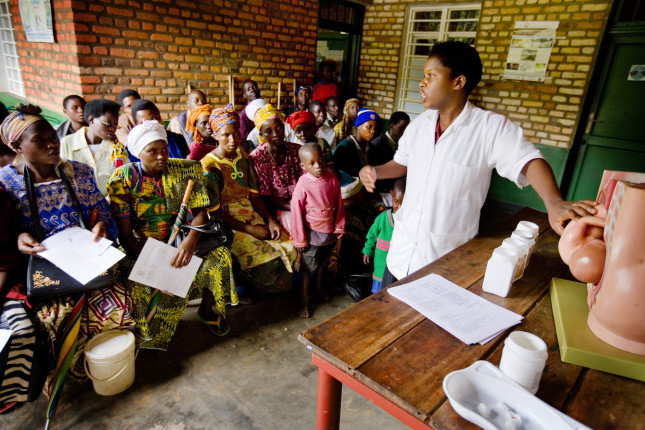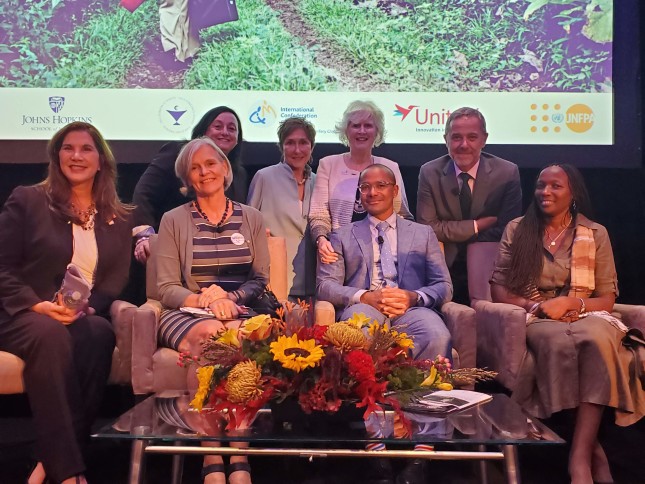-
To Achieve Universal Health Care, Invest in Nurses and Midwives

Universal health coverage, a sustainable development goal championed by Dr. Tedros Adhanom Ghebreyesus, Director-General of the World Health Organization (WHO), won a key vote of confidence during this year’s United Nations General Assembly in New York City. The member states endorsed primary health care as a means to reach more than 4 billion people who lack essential care—a critical gap to the achievement of universal health coverage by 2030.
Dr. Ghebreyesus summed up the significance of the General Assembly’s action, immediately following the vote: “Today world leaders approved the most comprehensive health declaration in history,” he tweeted. “Our vision is not health for some. It’s not health for most. It’s #HealthForAll: rich and poor, able and disabled, old and young, urban and rural, citizen and refugee. Everyone, everywhere.”
Universal health coverage (UHC) dominated many of the conversations at events held during the UN General Assembly’s opening week. Health ministers, U.S. government leaders, presidents of nonprofits, and corporate executives led discussions on a range of topics, from financing universal health coverage to delivering quality care.
An impressive group of global health leaders spoke on the key role of nurses and midwives in achieving universal health coverage at “Power on the Path to UHC2030: Nurses and Midwives as Navigators, Innovators and Accelerators,” a September 23 event. They all agreed that we must invest in these frontline health workers and the health systems in which they work to provide health care for all.

Nurses and midwives are a critical link for people around the world to be able to access primary care. Representing 50 percent of the global health workforce, they deliver 80 percent of health care in developing nations.
Dr. Diane Gashumba, Rwanda’s Minister of Health and the event’s keynote speaker, described what nurse-based and midwife-based care look like.
“Nearly 90 percent of health care facilities in Rwanda are run by nurses,” said Dr. Gashumba. In under-resourced areas, she added, often there are no physicians, and a nurse may be the only health professional a person sees. It is also common that just one nurse or midwife cares for an entire district.
And too often, that sole health provider is not empowered to practice at the full scope of their capability.
In Rwanda, many women and families live far from a health center, making access to routine care difficult. As part of its commitment to achieve universal health coverage, the government of Rwanda has committed to build primary health care centers within a 25-minute walk of every home. Expanded access will “push our agenda to reach everyone and help every woman have access to the health services she deserves,” said Dr. Gashumba.
To ensure a full complement of care, facilities must be staffed with health workers who are able to provide all of the services for which they have trained. And input from nurses and midwives in leadership positions must be reflected in policy.
Two nurse leaders—Dr. Leslie Mancuso, President and CEO of Jhpiego, and Dr. Patricia Davidson, Dean of the Johns Hopkins School of Nursing—emphasized the importance of elevating nurses and midwives to positions of authority and policymaking.
“We must empower nurses and midwives with greater scope of practice to see change in the health of our most vulnerable populations,” said Dean Davidson.
“They are without question the navigators, innovators and accelerators that will drive countries toward universal health coverage,” said Dr. Mancuso.
Because of their central role in delivering health care, nurses and midwives are identifying ways to improve services with innovations that can be low-cost or revolutionary. In Botswana, for example, nurse-led research has paved the way for women to be at the center of collecting their own human papilloma virus (HPV) samples to screen for cervical cancer, an approach that would expand the number of women to be screened for this cancer and reduce deaths.
Midwives and nurses also are critical to ensuring reproductive rights are not left behind in the journey to universal health coverage. “Midwives are the essential first line professionals to sexual and reproductive health rights. They are central to any universal health coverage program,” said Emmanuelle Hébert, Professor of Midwifery at the University of Québec at Three Rivers. Nurses and midwives often work together to ensure that women experience a pregnancy and birth that is both safe and satisfying, whether in health facilities or when necessary or desired by a woman in her home. Both play an essential role in following up after birth to ensure that mom and her baby are healthy, including in referring them for higher level care.
Marisol Touraine, Chair of the Unitaid Executive Board, explained why: “Nurses (and midwives) are present in all settings of care. They have direct contact with women and children, and are mostly women.” They are in position for advocacy, she added.
Along with representatives from the United Nations Population Fund and World Health Organization, she advocated investment in the health workforce to hire an additional 18 million health providers needed to achieve universal health coverage, protect women’s reproductive rights, and ensure gender equality. “Nurses and midwives are leaders,” said Anneka Knutsson, Chief of the Sexual and Reproductive Health Branch at UNFPA. “We must pay, value, and compensate them.”
Joy Marini, Global Director of Women’s Health at Johnson & Johnson and an event panel member, identified four key avenues to pursue: employ better policies to unlock health provider practices, tailor technology to local settings to connect health workers, be realistic about the challenges we face, and be more inclusive in developing a response.
With WHO declaring 2020 the “Year of the Nurse and Midwife,” Dr. Mancuso said, “The world is watching. It’s our duty to act.”
Sydnee Logan is Social Media & Digital Content Coordinator at Johns Hopkins School of Nursing.
Ann LoLordo is the Senior Director of Global Engagement and Communications at Jhpiego.
Sources: Jhpiego, Johns Hopkins School of Nursing, Johnson & Johnson, Republic of Rwanda’s Ministry of Health, UHC2030, UnitAid, UNFPA, World Health Organization.
Photo Credits: Photos courtesy of Jhpiego. All rights reserved.
Lead Photo: Nurses run nearly 90 percent of health care facilities in Rwanda and are often the only health professional a person will see. Rwanda plans to build primary health care centers within 25 minutes from every home, helping to expand access to essential health services to women and families.
 A Publication of the Stimson Center.
A Publication of the Stimson Center.




